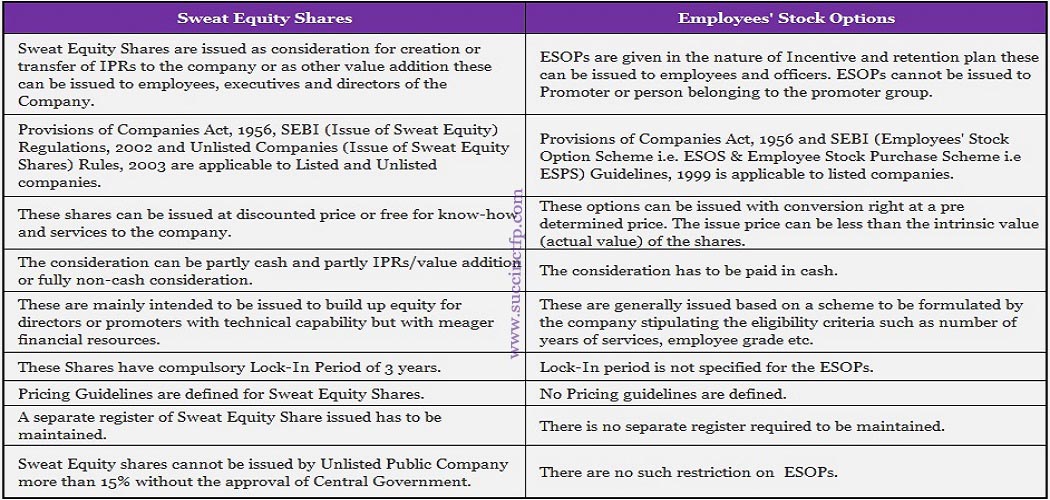Sweat equity and employee stock options
ESOP AND TAX IMPACT.
An Employee Stock Option Plan ESOP is an option given to the employees to buy the shares of the Company. Until the option is exercised and converts into a share, an option holder does not get any shareholder rights of voting, dividends and the like.
An Option is valuable because it gives the right to purchase the shares at typically a pre-determined price, and therefore gives the employee an upside to the current value of the share. Please read our 5 part blog series, which gives a complete overview here.
An ESOP can be used for multiple purposes — as a talent retention tool, as an incentive, as a remuneration mechanism. Accordingly the parameters of the plan would be tailored, if retention, then probably the vesting period would be kept longer. If incentive, then probably the Exercise Price would be kept low, may be face value of shares, so that the employee enjoys a high upside, if remuneration tool, then the eligibility criteria would possibly be all employees.
But typically, it is a combination of all of these factors and hence a good balance is required to be detailed in the Plan. An Option is different from Sweat Equity. Also, tax treatment and accounting treatment is different compared to Options.
Tax Impact — ESOP: Under ESOP, there is double incidence of tax on the employee. That is, first at the time of Exercise and second at the time of sale of shares by the employee. Depending on when the sale is undertaken by the employee, the capital gains will be either Short term or Long term capital gains. Sale within a period of 12 months is considered as Short term capital gain tax, and sale after 12month is considered as Long term capital gain tax. Issue of sweat equity shares is governed by the provisions of S.
In terms of the said Section, a company may issue sweat equity shares of a class of shares already issued, if the following conditions are satisfied:.
Unlisted Companies Issue of Sweat Equity Shares Rules, Rules: The guidelines referred to in S. Rule 8 prescribes that the issue of sweat equity shares to employees and directors shall be at a fair price calculated by an independent valuer. As per Income Tax Act, valuation shall be determined as per Discounted Free Cash Flow method. If this limit is to be exceeded, the same is required to be done with the prior approval of the Central Government.
Rule 10 provides sweat equity shares issued to employees or directors shall be locked in for a period of three years from the date of allotment. Sweat Equity shares as per the Income Tax Act, has 2 aspects. Whenever an employee receives a sweat equity shares, the value of such shares will be taxable as a perquisite under the head Salaries as per section 17 of IT Act.
As per the period of holding, Short term or Long term capital gains shall be applicable. When Shares are allotted against services rendered or towards know-how, IP etc.
TDS as applicable to the services invoice. Shares allotted at the Board meeting and Forms 2 and 3 filed with ROC along with the relevant agreement for the services. This is not a legal opinion and should not be considered as one.
omenejomy.web.fc2.com :: Sweat Equity vs ESOP
Please check with your attorney before taking any actions. Can sweat equity be issued to non employees like a local or foreign technical consultant for the predetermined value of the consultancy if the company is short of funds and the consultant is OK with it.
Joseph, With the new Companies Act , wef 1 April , you can issue sweat to Indian, but it has become very procedural. For a foreign consultant, there are formalities at RBI that needs to be followed. Also, it depends on which sector your company is in.
You are commenting using your WordPress. You are commenting using your Twitter account.
Sweat Equity Shares and Employee’s Stock Option
You are commenting using your Facebook account. Notify me of new comments via email. Enter your email address to subscribe to this blog and receive notifications of new posts by email. Posted on April 24, by novojuris.
Founders have this question and here is a comparative: ESOP AND TAX IMPACT An Employee Stock Option Plan ESOP is an option given to the employees to buy the shares of the Company. Is the act of commitment by the employer through informing the employee of the eligibility for the Options under ESOP.
Vesting percentage is the portion of the total options Granted which can be exercised on completion of the Vesting Period.
Comparison Between Sweat Equity Shares and ESOP
Any time after the Vesting Period within which the employee has to Exercise. After a certain period, typically termination, expiry of Exercise Period the Options lapse and cannot be converted to Shares.
SWEAT EQUITY SHARES Sweat Equity Shares — Companies Act, Issue of sweat equity shares is governed by the provisions of S. In terms of the said Section, a company may issue sweat equity shares of a class of shares already issued, if the following conditions are satisfied: This entry was posted in Uncategorized and tagged ESOP , shares for services , Sweat Equity , Tax on ESOP , tax on sweat equity , unlisted companies issue of sweat eequity. April 7, at 7: April 7, at 9: Leave a Reply Cancel reply Enter your comment here Fill in your details below or click an icon to log in: Email required Address never made public.

Create a free website or blog at WordPress.